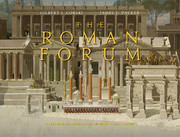Preface
Published online by Cambridge University Press: 05 March 2015
Summary
If Roman builders and their patrons sired a great architecture now in ruins, we, who wander through the ruins with open eyes and ears, are parents to its refashioning.
Rabun TaylorWhy another book on the Roman Forum (Figs. 0.1–4, 1.2–6)? Surely, the many who have written on the site in the nineteenth and twentieth centuries will have described it so thoroughly that they must have satisfied all possible future interest. Surprisingly, that is not the case. Works on the Forum fall into three general categories: archaeological reports, articles in learned journals and monographs, and guidebooks. For most readers in English, the archaeological reports and the articles, largely in foreign languages, usually Italian, German, and French (listed here roughly according to the volume of material available in each), are virtually incomprehensible. And should the casual reader live near a good university library and have the skills and interest necessary to access these essays, he/she will find simple descriptions of the topography of the site and objects found, with or without exegesis, and technical discussions of difficult, special problems.
While recent archaeological monographs may investigate a single building in detail, they do not necessarily reconstruct its original appearance. They include invaluable measured drawings of architectural elements and standing ruins, but they normally do not use these elements in measurable restored plans, elevations, and sections. They consider neither the relationship of their monument to its neighbors nor its conceptual part in the design of the whole Forum. Guidebooks in English are sometimes more helpful, but they also have their limitations. Their short sections usually do little more than identify and briefly characterize each monument, and even their longer entries present every structure either as an excavation or as a three-dimensional nexus for an essay on relevant historical sources. In other words, neither scholarly articles and specialized monographs nor guidebooks in English treat the Forum as an architectural entity.
- Type
- Chapter
- Information
- The Roman ForumA Reconstruction and Architectural Guide, pp. xiii - xxPublisher: Cambridge University PressPrint publication year: 2015



